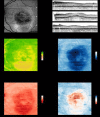AI-based structure-function correlation in age-related macular degeneration
- PMID: 33767409
- PMCID: PMC8302753
- DOI: 10.1038/s41433-021-01503-3
AI-based structure-function correlation in age-related macular degeneration
Abstract
Sensitive and robust outcome measures of retinal function are pivotal for clinical trials in age-related macular degeneration (AMD). A recent development is the implementation of artificial intelligence (AI) to infer results of psychophysical examinations based on findings derived from multimodal imaging. We conducted a review of the current literature referenced in PubMed and Web of Science among others with the keywords 'artificial intelligence' and 'machine learning' in combination with 'perimetry', 'best-corrected visual acuity (BCVA)', 'retinal function' and 'age-related macular degeneration'. So far AI-based structure-function correlations have been applied to infer conventional visual field, fundus-controlled perimetry, and electroretinography data, as well as BCVA, and patient-reported outcome measures (PROM). In neovascular AMD, inference of BCVA (hereafter termed inferred BCVA) can estimate BCVA results with a root mean squared error of ~7-11 letters, which is comparable to the accuracy of actual visual acuity assessment. Further, AI-based structure-function correlation can successfully infer fundus-controlled perimetry (FCP) results both for mesopic as well as dark-adapted (DA) cyan and red testing (hereafter termed inferred sensitivity). Accuracy of inferred sensitivity can be augmented by adding short FCP examinations and reach mean absolute errors (MAE) of ~3-5 dB for mesopic, DA cyan and DA red testing. Inferred BCVA, and inferred retinal sensitivity, based on multimodal imaging, may be considered as a quasi-functional surrogate endpoint for future interventional clinical trials in the future.
摘要: 对于年龄相关性黄斑变性(AMD)的临床试验来说, 敏感且强大的视网膜功能测量手段是至关重要的。近期的新进展是利用人工智能(AI)来解释多模式影像成像的心理物理检查结果。我们以“人工智能”和“机器学习”为关键词, 结合“视野测量”、“最佳矫正视力(BCVA)”、“视网膜功能”和“年龄相关性黄斑变性”, 对PubMed和Web of Science中的文献进行了综述。到目前为止, 基于人工智能的结构功能相关性的研究已被应用于传统的视野检查、FCP视野检查、视网膜电生理检查以及BCVA的检查和患者报告结果(PROM)的测量。对于新生血管性AMD, BCVA推理法(以下称为BCVA推测法)可以评估BCVA结果, 其均方根误差大约为7-11个字母, 这与实际视力评估的准确性相当。此外, 基于人工智能的结构功能相关性的研究可以成功推测FCP视野检查的结果, 包括中间视觉、暗适应(DA)青色和红色试验(以下称为灵敏度推测法)。通过增加短时间的FCP检查, 可以提高灵敏度推测法的准确性, 对于中间视觉法、暗适应青色法和暗适应红色法, 其平均绝对误差(MAE)约为3-5 dB。基于多模态成像的BCVA推测法和视网膜灵敏度推测法, 可被认为是未来干预性临床试验的功能评估手段的替代终点。.
© 2021. The Author(s).
Conflict of interest statement
The Department of Ophthalmology, University of Bonn, received nonfinancial support for research material from CenterVue SpA, Padova, Italy, Heidelberg Engineering, Heidelberg, Germany, and Carl Zeiss Meditec, Jena, Germany.
Figures


References
-
- Holz FG, Sadda SR, Busbee B, Chew EY, Mitchell P, Tufail A, et al. Efficacy and safety of lampalizumab for geographic atrophy due to age-related macular degeneration: chroma and spectri phase 3 randomized clinical trials. JAMA Ophthalmol. 2018;136:666–77. doi: 10.1001/jamaophthalmol.2018.1544. - DOI - PMC - PubMed
-
- Lindner M, Nadal J, Mauschitz MM, Luning A, Czauderna J, Pfau M, et al. Combined fundus autofluorescence and near infrared reflectance as prognostic biomarkers for visual acuity in foveal-sparing geographic atrophy. Investig Ophthalmol Vis Sci. 2017;58:BIO61–7. doi: 10.1167/iovs.16-21210. - DOI - PubMed
Publication types
MeSH terms
Substances
LinkOut - more resources
Full Text Sources
Other Literature Sources
Miscellaneous

